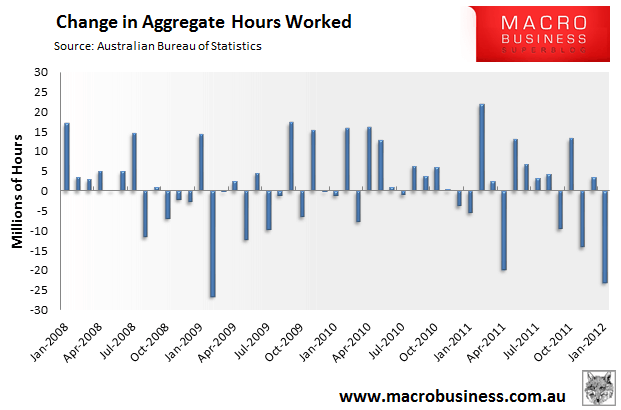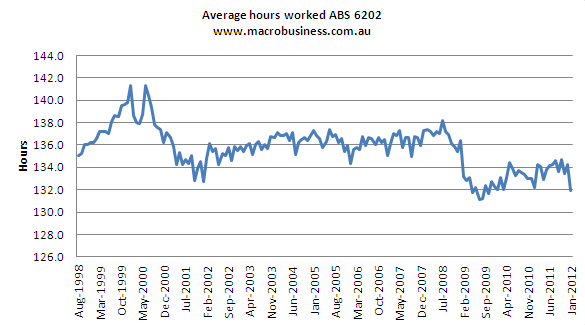As the Unconventional Economist describes today, yesterday’s employment number although excellent contained one dark spot, a big fall in hours worked. The trend in hours worked has also very clearly been down through the last quarter of last year:

The unemployment rate, however, has essentially been unmoved. I can think of two explanations for this. The first is that most most commonly put today, that the inflating sectors of the economy have enough momentum to absorb resources from the deflating sectors. So, although man hours are sliding in total, jobs are plentiful enough.
An alternative explanation is that the Australian labour market has developed along lines more redolent of Europe than the US. By that I mean we have something more akin to Germany’s “kurzarbeit” system than we do the slash and burn approach of US laissez faire capitalism. The basic difference is that Germany has a formal system of automatic stabilisers called “kurzabeit” that revolves around private firms reducing man hours (and the government making up some of the difference in pay) versus the US approach of treating jobs as a variable cost that gets cut when trouble starts. In short, the Germans cut hours while the Americans cut people.
Critics of the German system tend to see it as a kind of zombie capitalism. But it has certainly worked for Germany, especially so since the GFC during which its labour market eased much less than many other nations and rebounded more quickly as well. Though one could certainly argue the system is being subsidised by the rest of Europe via a weak euro.
If Australia is more oriented towards the former it has important implications for policy and national productivity. Australia does not have a heavily regulated labour market like Germany, as the following OECD chart of Indicators of Employment Protection shows:

Unfortunately this measure is only updated infrequently and this is 2008. No doubt we have shifted some since but it does give a guide to how liberal, in fact, our labour market is.
Nonetheless, for the last decade the Australian labour market has been so strong that a private approximation of the German kurzabeit system has developed. Some call it labour hoarding and it is the willingness to use such approaches as reduced hours across a majority of staff rather than cut a minority owing to the fear that skill shortages will cost more in the long run if staff are let go. I think values also play a part. To support a US-style slash and burn system you need a very powerful underlying identity of individual empowerment. Australia’s “fair go” culture is more collectively supportive.
In the dark days of the GFC , “Australian kurzabeit” is widely accepted to have prevented much larger job losses. Take a look at this chart of average hours worked:

Note that the average work week rose through the downturn across the millennium as employers sought to make more from less people but the opposite occured in the GFC as employers sought to do less with more people. This certainly protected jobs. The downside, however, is that this is also a contributor to our productivity problem, as businesses spreads less hours over more people to ensure they have the depth of staff needed to address demand.
It has been one of my key tenets for the year ahead that Australia’s big employment sectors are likely to move from denial that the good times are over into acceptance and, with that, shift to accelerated job losses and rising productivty. There has been evidence that this is transpiring as the average work week trended up through 2011. And more so recently with the announcement of mass layoffs in the reporting season. But as you can see, with the accelerating trend in falling man hours and the big January drop (which is seasonally adjusted), it looks like many businesses may still be holding to the informal kurzarbeit system that has defined the labour market for a decade.
It’s either that or, as Saul Eslake suggests in today’s AFR, they are struggling get around a newly rigid labour market:
Given the inadvisability of drawing conclusions about productivity from data over relatively short periods, it is not yet possible to make any reliable statistically based inferences about the effects of the present government’s changes to workplace relations arrangements on economy-wide productivity growth. Although there does appear to be a growing body of anecdotal evidence that some businesses are seeking to make productivity-enhancing organisational changes in workplaces, they are finding those changes more difficult to implement than might have been the case hitherto.
As I have said before, I do think the pendulum on labour regulation has swung too far back. For instance, I don’t see why small businesses should be so shackled by unfair dismissal laws. But at the same time, I am a fan of a balanced approach to industrial relations. As the US example of the past cycle shows, overly liberated capital and labour markets tend, over time, to hollow out your middle class.
A couple of final points then. If this supposition is right then the current labour market shakeout has a long way yet to run. That’s not to say it will get dramtically worse. It may be that the current pace of correction continues but is extended and we get a slow rise in the unemployment rate throughout the year. It may also be that the inflating sectors are enough to keep the rate flat. In either case, I’m not sure we should be rushing in to liberalise the labour market at this point (even though I agree we need to). As we deflate the borrow and spend economy of yesteryear, our informal (and newly more rigid) labour market may be helping prevent a more swfit and disorderly unwind.

